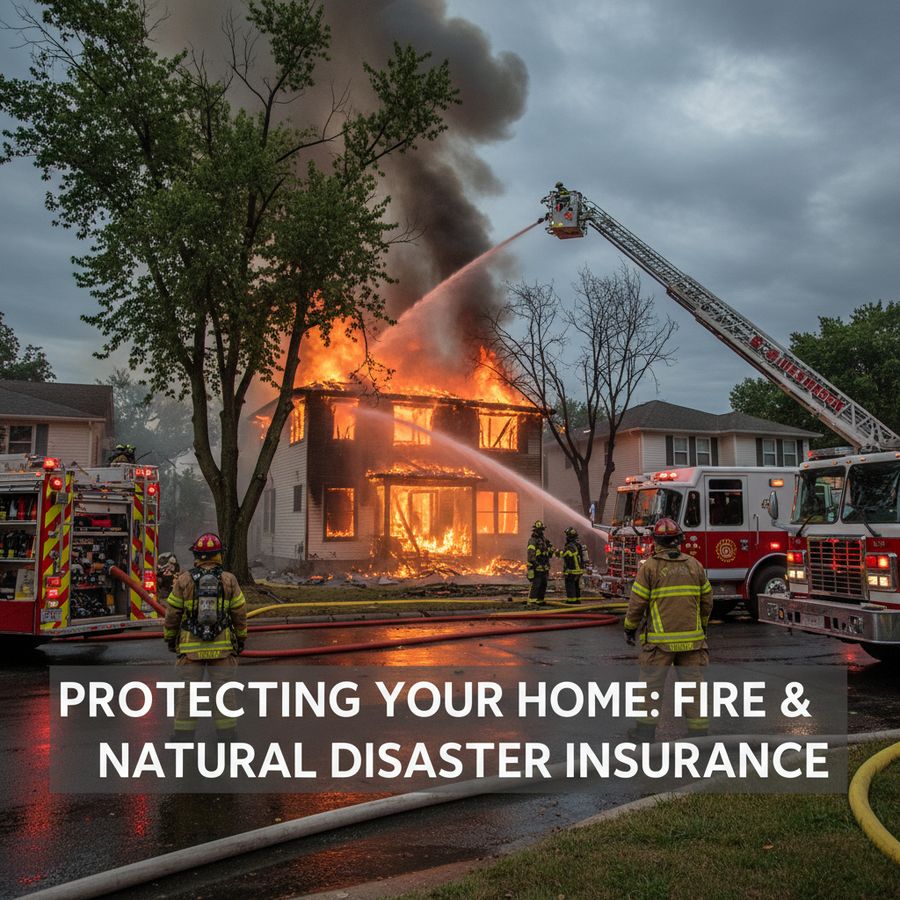Top Risks Covered by Property Insurance Policies
Overview
Property insurance is a crucial safeguard for homeowners, renters, and business owners alike, designed to protect against a variety of risks that can result in significant financial losses. At its core, property insurance provides risk coverage by reimbursing policyholders for damages to their physical assets caused by unforeseen events. Understanding the top risks covered by property insurance policies helps individuals make informed decisions about the type and extent of coverage they need.
Typically, property insurance policies encompass protection against both natural and man-made perils. The range of covered risks can vary depending on the specific policy, insurer, and jurisdiction, but certain risks are commonly included as foundational coverage. A well-rounded property insurance plan not only protects the structure itself but often extends to personal belongings and may include liability components, which shield the insured from legal responsibilities arising from accidents on the property.
Fire insurance is one of the most fundamental aspects of property insurance, addressing the risk of fire damage that can devastate homes and businesses. In addition to fire, policies often cover natural disasters such as storms, hail, and earthquakes, though some may require additional riders or endorsements for full protection against specific hazards.
Moreover, theft protection is a critical part of most property insurance policies, offering peace of mind against losses caused by burglary or vandalism. Liability insurance, often included in property policies, protects insured parties from claims related to bodily injury or property damage suffered by third parties on the insured premises.
"Choosing the right property insurance policy means understanding which risks are covered and ensuring your protection aligns with your unique exposure."
In the sections that follow, we will explore the primary risks covered by property insurance policies in detail, including fire and natural disasters, theft and vandalism, liability protection, water damage, and additional perils that may affect your property. This comprehensive overview will equip you with the knowledge needed to select the coverage that best fits your needs.

Fire and Natural Disasters
Fire insurance is often considered the cornerstone of property insurance due to the potentially catastrophic consequences of fire damage. A fire can rapidly consume a home or commercial property, causing structural destruction and loss of valuable possessions. Property insurance policies generally cover damage caused by accidental fires, including smoke damage and the cost of firefighting efforts.
Beyond fire, natural disasters represent some of the most significant risks to property. Many basic policies cover common perils such as windstorms, hail, lightning, and even volcanic eruptions. However, coverage for other natural disasters like earthquakes, floods, and hurricanes often requires specialized endorsements or separate policies.
For instance, flood damage is typically excluded from standard property insurance but can be insured through government-backed flood insurance programs or private flood policies. Earthquake insurance is similarly excluded in many areas and necessitates additional coverage. Understanding these nuances is essential for comprehensive protection.
Key natural disaster risks commonly covered include:
Wind and hail damage
Lightning strikes
Smoke and fire spread from nearby events
Volcanic activity
Property owners in regions prone to specific natural disasters should consult their insurer to verify whether these risks are included or require extra coverage. Investing in adequate fire and natural disaster insurance safeguards your assets against unpredictable events that could otherwise result in severe financial hardship.
"Natural disasters are unpredictable, but with the right property insurance, you can mitigate the financial impact and recover more quickly."

Theft and Vandalism
Theft protection and vandalism coverage are vital components of property insurance that shield the policyholder from losses caused by criminal acts. Burglary and break-ins can result in stolen valuables, damage to doors, windows, and security systems, and the distress of compromised safety. Vandalism, which includes intentional damage to property such as graffiti or broken fixtures, can also incur significant repair costs.
Most property insurance policies include coverage for theft and vandalism as part of their standard risk protection. This coverage typically reimburses the insured for stolen personal property and repairs necessary to restore the property to its pre-loss condition. However, policy limits and deductibles apply, and high-value items such as jewelry or artwork may require additional endorsements or separate policies to be fully covered.
Effective theft protection starts with understanding the extent of coverage and taking proactive measures such as installing security systems, proper locks, and lighting to deter criminals. Insurers may offer discounts or incentives for enhanced security features, which can reduce premiums while increasing protection.
In some cases, coverage for theft and vandalism extends beyond the physical structure to include outbuildings, fences, and landscaping. It is important to review your policy details carefully to ensure these elements are covered if necessary.
"Protecting your property from theft and vandalism is not only about insurance—it’s about peace of mind and safeguarding your investment."
Liability Protection
Liability insurance is an indispensable part of many property insurance policies, offering protection against legal claims if someone is injured or suffers property damage while on your premises. This coverage helps pay for medical expenses, legal fees, and settlements or judgments in lawsuits, shielding you from potentially devastating financial burdens.
Liability insurance is especially important for homeowners and landlords, as accidents such as slips and falls, dog bites, or damage caused by children or pets can lead to liability claims. Without this coverage, the insured could be personally responsible for costly damages or legal costs.
Typical liability protection covers:
Bodily injury to visitors or guests
Property damage to others caused by the insured or family members
Medical payments regardless of fault (in some policies)
Legal defense costs
Some policies also include personal liability coverage that extends beyond the property itself, covering incidents occurring away from the insured premises. This broader protection is valuable for safeguarding your overall financial security.
When selecting property insurance, it is crucial to understand the limits of your liability coverage and consider purchasing additional umbrella insurance if your risk exposure is higher. Liability protection ultimately provides a vital safety net against unforeseen events that could otherwise jeopardize your financial stability.
"Liability insurance turns unforeseen accidents into manageable situations by protecting your assets and peace of mind."
Water Damage Coverage
Water damage is one of the most common and costly risks covered by property insurance policies. It can arise from a variety of sources including burst pipes, accidental overflows, sewer backups, and appliance failures. However, it is important to distinguish between different types of water damage, as not all are covered under standard property insurance.
Typically, property insurance covers water damage caused by sudden and accidental incidents such as a burst pipe or an overflowing washing machine. This coverage often includes repairs to the structure, replacement of damaged personal property, and mitigation costs to prevent further damage.
Conversely, damage resulting from gradual leaks, poor maintenance, or flooding is usually excluded unless specific endorsements are purchased. Flood damage, in particular, requires separate coverage through specialized flood insurance programs.
Preventative measures such as regular plumbing inspections, installing water sensors, and maintaining gutters and drainage systems can help reduce the risk of water damage and potential claims. Some insurers may also offer discounts for homes equipped with these protective features.
Common water damage sources covered include:
Burst or frozen pipes
Accidental overflows (e.g., sinks, tubs)
Water heater leaks
Appliance malfunctions
Being aware of your policy’s water damage provisions ensures you are adequately protected and can respond quickly if water damage occurs, minimizing disruption and financial loss.
"Water damage coverage safeguards your property against one of the most frequent and expensive perils affecting homeowners and renters alike."
Additional Perils
Beyond the major risks such as fire, theft, liability, and water damage, property insurance policies often cover a range of additional perils that can threaten your property. These risks may vary widely depending on location, policy type, and insurer but can include:
Falling objects: Damage caused by items like tree limbs or debris falling onto the property.
Weight of ice and snow: Structural damage resulting from excessive accumulation on roofs or other parts of the building.
Freeze damage: Damage caused by freezing temperatures affecting plumbing or building materials.
Electrical surges: Damage to electrical systems and appliances resulting from power surges.
Damage from vehicles or aircraft: Impact resulting from accidental collisions with the insured property.
Many policies also provide coverage for additional living expenses if the property becomes uninhabitable due to a covered loss, helping with temporary housing and related costs. This feature is particularly important for homeowners who rely on their property as their primary residence.
To maximize protection, policyholders should carefully review their insurance documents and discuss with their insurer any unique risks they face, ensuring appropriate endorsements or riders are added as needed.
"Considering additional perils broadens your safety net, ensuring peace of mind against less common but potentially costly incidents."
Conclusion
Understanding the top risks covered by property insurance policies is essential for anyone looking to protect their valuable assets from unexpected events. From foundational coverage like fire insurance and theft protection to critical safeguards such as liability insurance and water damage coverage, these protections collectively reduce financial exposure and provide peace of mind.
Each property owner’s needs are unique, so it is vital to assess the specific risks relevant to your location, property type, and lifestyle. Collaborating with a knowledgeable insurance agent can help tailor a policy that encompasses all necessary coverages, including additional perils and endorsements. To explore your options further, you can check out this resource.
In summary:
Fire and natural disasters pose significant threats that require adequate coverage.
Theft and vandalism protection safeguards against criminal acts and property damage.
Liability insurance protects you from legal and financial consequences of accidents on your property.
Water damage coverage addresses one of the most common and costly insurance claims.
Additional perils and living expense coverage enhance overall protection.
Investing in comprehensive property insurance is an informed step toward securing your home, belongings, and financial future against a broad spectrum of risks.
"A well-rounded property insurance policy is an investment in security, helping you recover and rebuild with confidence after life's unexpected challenges."
Reacties
Een reactie posten